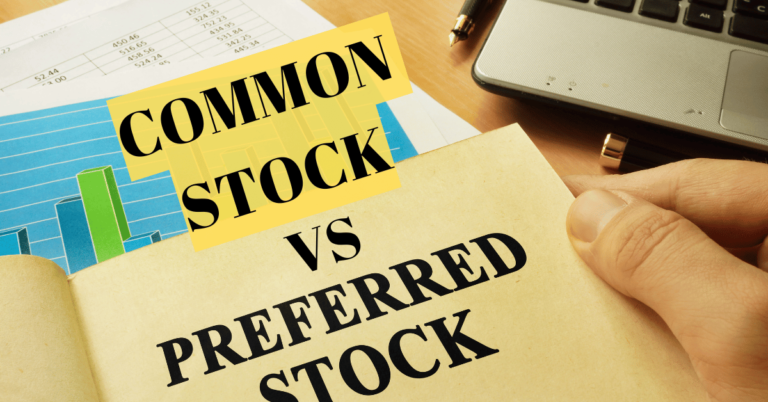When you invest in a company, you often have the option to purchase preferred stock or common stock. Both types represent a share in the ownership of the company, but they are not created equal.
Preferred stock offers more stability, while common stock provides higher growth potential. Understanding the differences between the two is crucial for making informed investment decisions.
What is Preferred Stock?

Preferred stock is a type of equity that has characteristics similar to both bonds and stocks. Like bonds, preferred stocks provide a steady, predictable stream of income through dividends. Unlike common stocks, the price of preferred stocks tends to be less volatile.
Bond-Like Characteristics
Preferred stocks are known for their bond-like nature. Investors receive regular dividend payments, typically at a fixed rate, making them attractive for income-focused investors. However, these stocks also have a par value and are affected by interest rates. When interest rates rise, the value of preferred stock may decrease.
Dividend Preference
One of the biggest advantages of preferred stock is the priority in dividend payments. Preferred shareholders are paid dividends before common shareholders, and these dividends are often higher. If a company skips a dividend payment, it must pay arrears to preferred shareholders before common stockholders receive anything.
What is Common Stock?
Common stock is the most well-known type of equity. When people talk about “stocks,” they are generally referring to common stock. Common stockholders share in the company’s profits and have voting rights, which gives them a voice in corporate decisions.
Voting Rights
One of the major benefits of common stock is the voting rights it grants. Common shareholders typically have one vote per share, allowing them to influence major decisions, such as electing the board of directors or approving mergers.
Growth Potential
While common stockholders are last in line to receive assets in the event of liquidation, they have much greater growth potential than preferred shareholders. If the company performs well, the value of the common stock can rise significantly, leading to higher returns.
Key Differences Between Preferred and Common Stock
Payment Priority
In the event of a company’s liquidation, preferred shareholders have a higher claim on the company’s assets than common shareholders. This means that preferred stockholders are paid before common stockholders, which makes them a safer investment in this regard.
Volatility
Common stock tends to be much more volatile than preferred stock. While preferred stock prices remain relatively stable, common stock prices fluctuate based on market conditions, making them riskier but potentially more rewarding.
Voting Rights
Preferred stockholders typically do not have voting rights, while common stockholders do. This lack of influence on company decisions is a key difference between the two.
Dividends
Preferred stock offers fixed dividends that are paid out before any dividends are given to common stockholders. On the other hand, dividends for common stockholders are not guaranteed and depend on the company’s performance.
Advantages of Preferred Stock
Fixed Dividend Income
Preferred stock is a great choice for investors looking for steady income. The fixed dividend rate provides a predictable cash flow, making it ideal for risk-averse investors who want reliable returns.
Stability in Value
Preferred stock is generally less volatile than common stock, which means its price doesn’t fluctuate as much. This stability makes it a safer choice for conservative investors.
Callability Feature
Preferred stocks often come with a callability feature, which allows the company to buy back the stock at a certain price after a specified period. This can benefit investors if the shares are called at a premium price.
Disadvantages of Preferred Stock
Limited Growth Potential
While preferred stock offers stability, it lacks the high growth potential that common stock can provide. Investors looking for long-term growth may find common stock more appealing.
No Voting Rights
Unlike common stockholders, preferred stockholders typically do not have a say in company decisions. This lack of voting rights can be a drawback for those who want to influence corporate governance.
Advantages of Common Stock
Voting Rights
Common stockholders have the ability to vote on important company matters, including the election of board members and major corporate policies. This gives them a level of influence that preferred stockholders do not have.
Unlimited Growth Potential
Common stock offers unlimited growth potential. If the company performs well, the value of the stock can increase significantly, leading to substantial capital gains for investors.
Disadvantages of Common Stock
Higher Risk and Volatility
Common stock is generally more volatile than preferred stock, meaning the price can rise and fall dramatically. This makes it a riskier investment, especially during times of market uncertainty.
Dividends Not Guaranteed
Unlike preferred stock, common stock dividends are not guaranteed. The company’s board of directors decides whether to pay dividends, and in many cases, no dividends are paid at all.
Payment Priority in Case of Liquidation
In the event of liquidation, preferred shareholders are paid before common shareholders. This gives preferred stockholders a higher claim on the company’s assets, making their investment safer in the event of bankruptcy.
Which Type of Stock Is Right for You?
Income vs. Growth Investors
Preferred stock is often favored by income investors because of its steady dividend payments, while growth investors may prefer common stock for its higher potential returns. Choosing between the two depends on your financial goals.
Risk Tolerance Considerations
If you’re a risk-averse investor, preferred stock may be the better choice due to its stability. However, if you’re willing to take on more risk for the possibility of higher rewards, common stock might be the way to go.
The Role of Dividends
Dividends play a crucial role in both types of stock. Preferred stock typically offers higher, fixed dividends, while common stock dividends are variable and not guaranteed.
Convertible Preferred Stock
Some preferred stocks are convertible, meaning they can be converted into common stock. This offers a unique opportunity for investors to benefit from both the stability of preferred stock and the growth potential of common stock.
Historical Context of Common Stock
Common stock has been around for centuries. The first common stock was issued by the Dutch East India Company in 1602, marking the beginning of stock trading as we know it.
Which Offers More Growth Potential?
While both types of stock have their benefits, common stock generally offers greater growth potential. Its price is more likely to rise significantly, especially if the company performs well, leading to capital gains.
Conclusion
Both preferred and common stocks have their advantages and disadvantages. Preferred stock offers stability and a steady income stream, making it a great option for conservative investors. On the other hand, common stock provides higher growth potential and voting rights, making it ideal for those willing to take on more risk. Ultimately, the right choice depends on your financial goals and risk tolerance.
So that’s it about this article. If you have any further questions, feel free to comment down below or contact finzerr.
Finzerr is always here to help you!
FAQs
1. Can preferred stock be converted into common stock?
Yes, convertible preferred stock allows shareholders to convert their shares into common stock, giving them the opportunity for potential growth.
2. Do preferred stockholders get voting rights?
Generally, preferred stockholders do not have voting rights, unlike common stockholders.
3. Which is riskier: preferred or common stock?
Common stock is generally riskier than preferred stock due to its higher volatility and the fact that dividends are not guaranteed.



